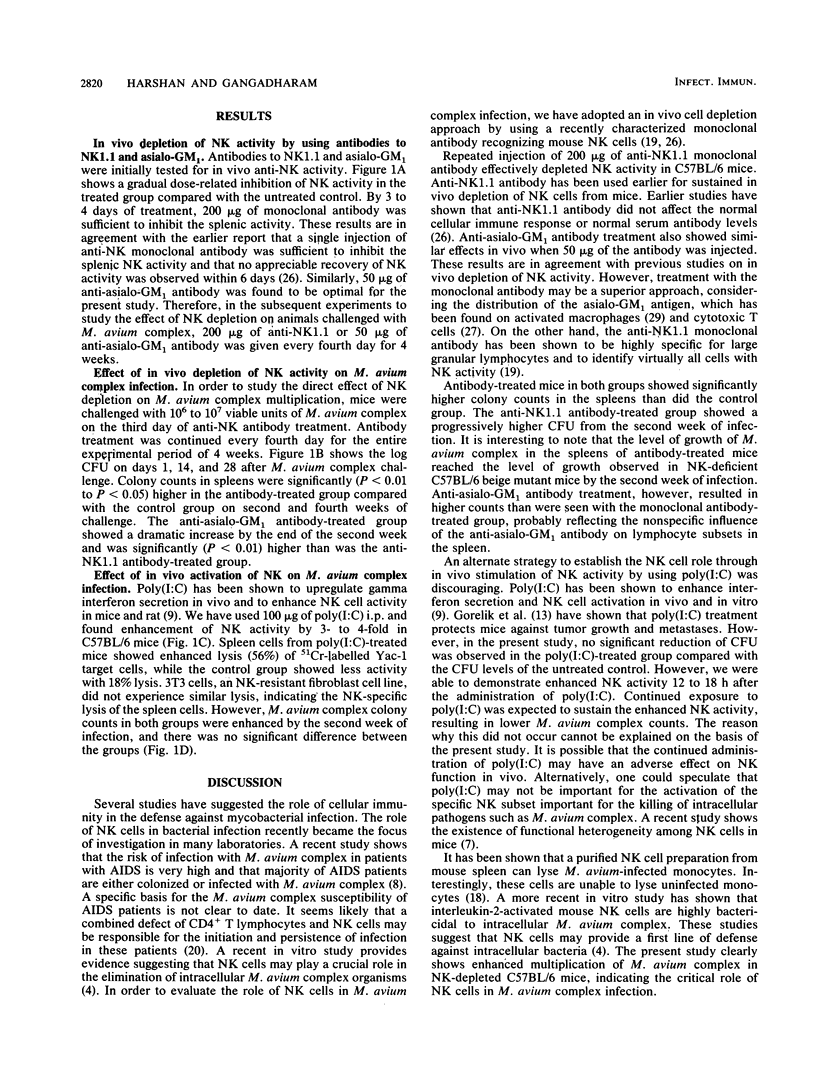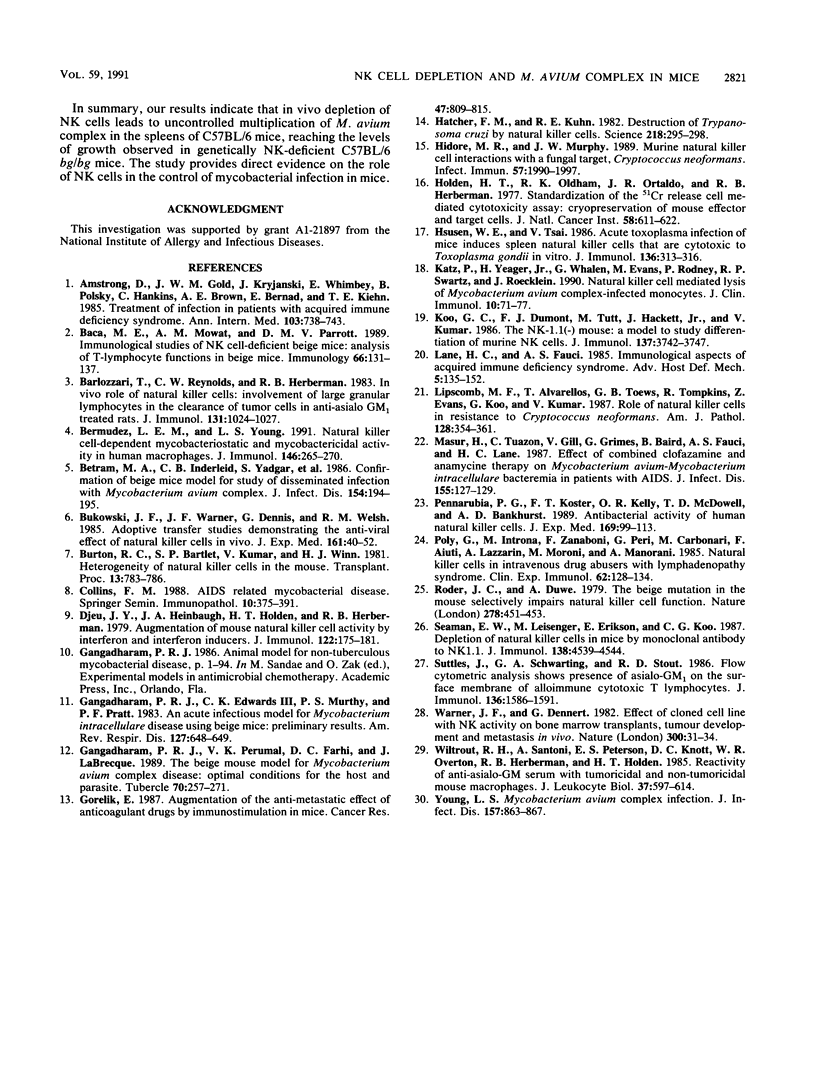Abstract
Earlier investigations have shown that murine natural killer (NK) cells inhibit the growth of fungal and bacterial pathogens in vivo and in vitro. In order to define the role of NK cells in Mycobacterium avium complex infection, in vivo depletion of NK cells by using anti-NK1.1 monoclonal antibody and conventional anti-asialo-GM1 antibody has been attempted. Repeated injection of 200 micrograms of anti-NK1.1 or 50 micrograms of anti-asialo-GM1 antibody effectively depleted NK activity in the spleens of C57BL/6 mice. The growth kinetics of M. avium complex over a period of 4 weeks showed that the colony counts in the spleens of the antibody-treated group were significantly (P less than 0.01) higher than those of the control group and compared well with those of the genetically NK cell-deficient C57BL/6 bg/bg mutant. The alternate strategy of in vivo stimulation of NK activity by poly(I:C) administration did not show a similar reduction in CFU in the spleen compared with the untreated control. The in vivo antibody depletion of NK activity provides direct evidence on the role of NK cells in the control of intracellular mycobacterial pathogens such as M. avium complex.
Full text
PDF



Selected References
These references are in PubMed. This may not be the complete list of references from this article.
- Armstrong D., Gold J. W., Dryjanski J., Whimbey E., Polsky B., Hawkins C., Brown A. E., Bernard E., Kiehn T. E. Treatment of infections in patients with the acquired immunodeficiency syndrome. Ann Intern Med. 1985 Nov;103(5):738–743. doi: 10.7326/0003-4819-103-5-738. [DOI] [PubMed] [Google Scholar]
- Baca M. E., Mowat A. M., Parrott D. M. Immunological studies of NK cell-deficient beige mice. II. Analysis of T-lymphocyte functions in beige mice. Immunology. 1989 Jan;66(1):131–137. [PMC free article] [PubMed] [Google Scholar]
- Barlozzari T., Reynolds C. W., Herberman R. B. In vivo role of natural killer cells: involvement of large granular lymphocytes in the clearance of tumor cells in anti-asialo GM1-treated rats. J Immunol. 1983 Aug;131(2):1024–1027. [PubMed] [Google Scholar]
- Bermudez L. E., Young L. S. Natural killer cell-dependent mycobacteriostatic and mycobactericidal activity in human macrophages. J Immunol. 1991 Jan 1;146(1):265–270. [PubMed] [Google Scholar]
- Bertram M. A., Inderlied C. B., Yadegar S., Kolanoski P., Yamada J. K., Young L. S. Confirmation of the beige mouse model for study of disseminated infection with Mycobacterium avium complex. J Infect Dis. 1986 Jul;154(1):194–195. doi: 10.1093/infdis/154.1.194. [DOI] [PubMed] [Google Scholar]
- Bukowski J. F., Warner J. F., Dennert G., Welsh R. M. Adoptive transfer studies demonstrating the antiviral effect of natural killer cells in vivo. J Exp Med. 1985 Jan 1;161(1):40–52. doi: 10.1084/jem.161.1.40. [DOI] [PMC free article] [PubMed] [Google Scholar]
- Burton R. C., Bartlett S. P., Kumar V., Winn H. J. Heterogeneity of natural killer cells in the mouse. Transplant Proc. 1981 Mar;13(1 Pt 2):783–786. [PubMed] [Google Scholar]
- Collins F. M. AIDS-related mycobacterial disease. Springer Semin Immunopathol. 1988;10(4):375–391. doi: 10.1007/BF02053847. [DOI] [PubMed] [Google Scholar]
- Djeu J. Y., Heinbaugh J. A., Holden H. T., Herberman R. B. Augmentation of mouse natural killer cell activity by interferon and interferon inducers. J Immunol. 1979 Jan;122(1):175–181. [PubMed] [Google Scholar]
- Gangadharam P. R., Edwards C. K., 3rd, Murthy P. S., Pratt P. F. An acute infection model for Mycobacterium intracellulare disease using beige mice: preliminary results. Am Rev Respir Dis. 1983 May;127(5):648–649. doi: 10.1164/arrd.1983.127.5.648. [DOI] [PubMed] [Google Scholar]
- Gangadharam P. R., Perumal V. K., Farhi D. C., LaBrecque J. The beige mouse model for Mycobacterium avium complex (MAC) disease: optimal conditions for the host and parasite. Tubercle. 1989 Dec;70(4):257–271. doi: 10.1016/0041-3879(89)90020-2. [DOI] [PubMed] [Google Scholar]
- Garcia-Peñarrubia P., Koster F. T., Kelley R. O., McDowell T. D., Bankhurst A. D. Antibacterial activity of human natural killer cells. J Exp Med. 1989 Jan 1;169(1):99–113. doi: 10.1084/jem.169.1.99. [DOI] [PMC free article] [PubMed] [Google Scholar]
- Gorelik E. Augmentation of the antimetastatic effect of anticoagulant drugs by immunostimulation in mice. Cancer Res. 1987 Feb 1;47(3):809–815. [PubMed] [Google Scholar]
- Hatcher F. M., Kuhn R. E. Destruction of Trypanosoma cruzi by Natural killer cells. Science. 1982 Oct 15;218(4569):295–296. doi: 10.1126/science.6812218. [DOI] [PubMed] [Google Scholar]
- Hauser W. E., Jr, Tsai V. Acute toxoplasma infection of mice induces spleen NK cells that are cytotoxic for T. gondii in vitro. J Immunol. 1986 Jan;136(1):313–319. [PubMed] [Google Scholar]
- Hidore M. R., Murphy J. W. Murine natural killer cell interactions with a fungal target, Cryptococcus neoformans. Infect Immun. 1989 Jul;57(7):1990–1997. doi: 10.1128/iai.57.7.1990-1997.1989. [DOI] [PMC free article] [PubMed] [Google Scholar]
- Holden H. T., Oldham R. K., Ortaldo J. R., Herberman R. B. Standardization of the chromium-51 release, cell-mediated cytotoxicity assay: cryopreservation of mouse effector and target cells. J Natl Cancer Inst. 1977 Mar;58(3):611–622. doi: 10.1093/jnci/58.3.611. [DOI] [PubMed] [Google Scholar]
- Katz P., Yeager H., Jr, Whalen G., Evans M., Swartz R. P., Roecklein J. Natural killer cell-mediated lysis of Mycobacterium-avium complex-infected monocytes. J Clin Immunol. 1990 Jan;10(1):71–77. doi: 10.1007/BF00917500. [DOI] [PubMed] [Google Scholar]
- Koo G. C., Dumont F. J., Tutt M., Hackett J., Jr, Kumar V. The NK-1.1(-) mouse: a model to study differentiation of murine NK cells. J Immunol. 1986 Dec 15;137(12):3742–3747. [PubMed] [Google Scholar]
- Lipscomb M. F., Alvarellos T., Toews G. B., Tompkins R., Evans Z., Koo G., Kumar V. Role of natural killer cells in resistance to Cryptococcus neoformans infections in mice. Am J Pathol. 1987 Aug;128(2):354–361. [PMC free article] [PubMed] [Google Scholar]
- Masur H., Tuazon C., Gill V., Grimes G., Baird B., Fauci A. S., Lane H. C. Effect of combined clofazimine and ansamycin therapy on Mycobacterium avium-Mycobacterium intracellulare bacteremia in patients with AIDS. J Infect Dis. 1987 Jan;155(1):127–129. doi: 10.1093/infdis/155.1.127. [DOI] [PubMed] [Google Scholar]
- Poli G., Introna M., Zanaboni F., Peri G., Carbonari M., Aiuti F., Lazzarin A., Moroni M., Mantovani A. Natural killer cells in intravenous drug abusers with lymphadenopathy syndrome. Clin Exp Immunol. 1985 Oct;62(1):128–135. [PMC free article] [PubMed] [Google Scholar]
- Roder J., Duwe A. The beige mutation in the mouse selectively impairs natural killer cell function. Nature. 1979 Mar 29;278(5703):451–453. doi: 10.1038/278451a0. [DOI] [PubMed] [Google Scholar]
- Seaman W. E., Sleisenger M., Eriksson E., Koo G. C. Depletion of natural killer cells in mice by monoclonal antibody to NK-1.1. Reduction in host defense against malignancy without loss of cellular or humoral immunity. J Immunol. 1987 Jun 15;138(12):4539–4544. [PubMed] [Google Scholar]
- Suttles J., Schwarting G. A., Stout R. D. Flow cytometric analysis reveals the presence of asialo GM1 on the surface membrane of alloimmune cytotoxic T lymphocytes. J Immunol. 1986 Mar 1;136(5):1586–1591. [PubMed] [Google Scholar]
- Warner J. F., Dennert G. Effects of a cloned cell line with NK activity on bone marrow transplants, tumour development and metastasis in vivo. Nature. 1982 Nov 4;300(5887):31–34. doi: 10.1038/300031a0. [DOI] [PubMed] [Google Scholar]
- Wiltrout R. H., Santoni A., Peterson E. S., Knott D. C., Overton W. R., Herberman R. B., Holden H. T. Reactivity of anti-asialo GM1 serum with tumoricidal and non-tumoricidal mouse macrophages. J Leukoc Biol. 1985 May;37(5):597–614. doi: 10.1002/jlb.37.5.597. [DOI] [PubMed] [Google Scholar]
- Young L. S. Mycobacterium avium complex infection. J Infect Dis. 1988 May;157(5):863–867. doi: 10.1093/infdis/157.5.863. [DOI] [PubMed] [Google Scholar]


